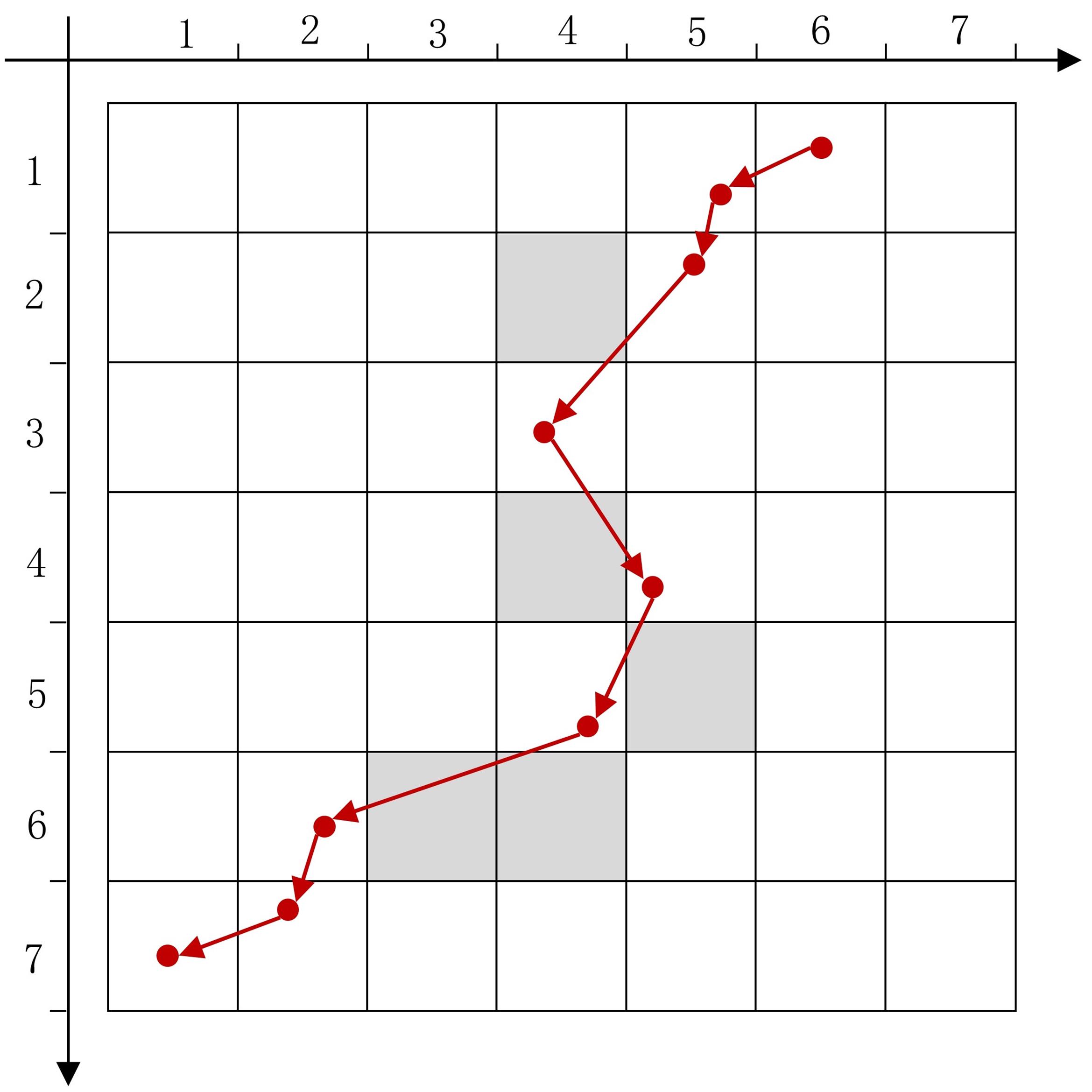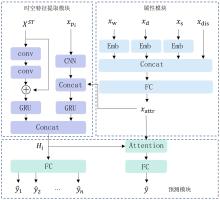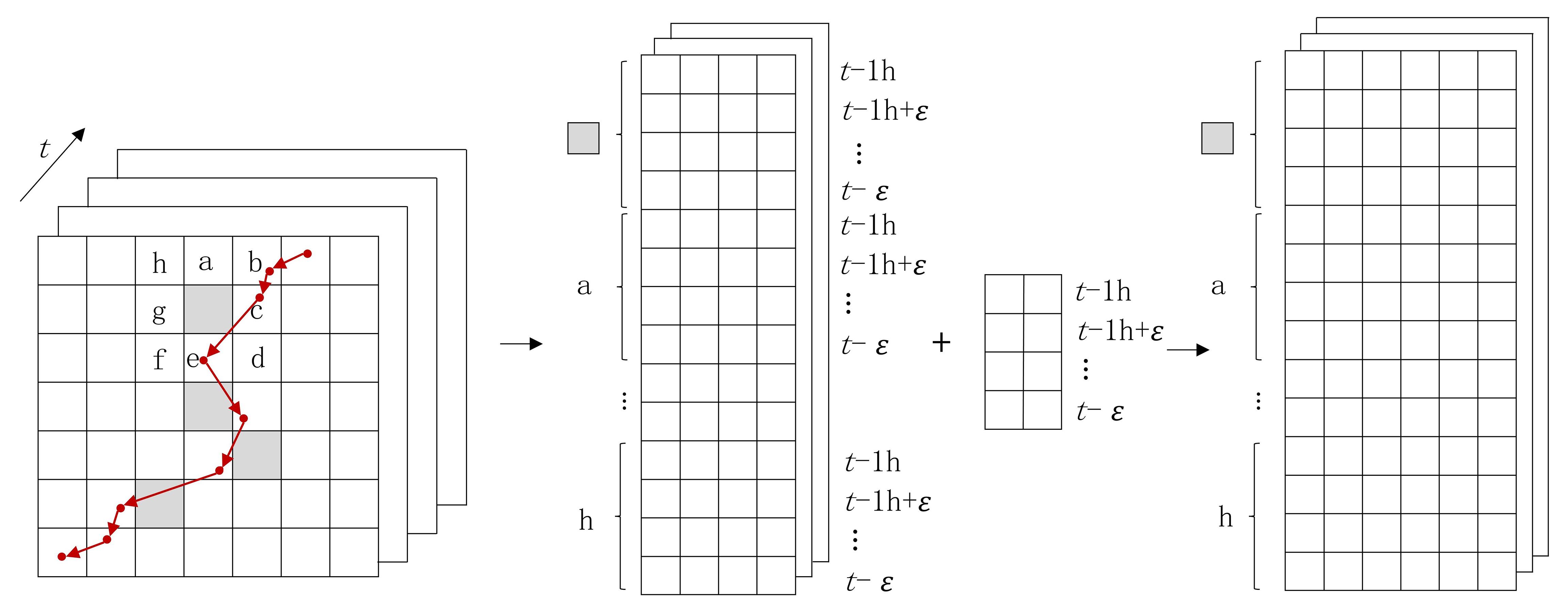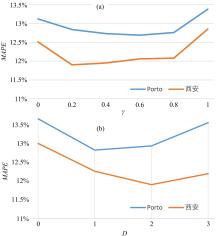南京大学学报(自然科学版) ›› 2022, Vol. 58 ›› Issue (4): 561–569.doi: 10.13232/j.cnki.jnju.2022.04.001
• • 下一篇
一种基于深度学习和元学习的出行时间预测方法
- 西南交通大学计算机与人工智能学院,成都,611756
A travel time estimation method based on deep learning and meta⁃learning
- School of Computer and Artificial Intelligences,Southwest Jiaotong University,Chengdu,611756,China
摘要:
出行时间预测是智慧交通系统中的一项基本任务,因其时空关系复杂且易受到外部因素影响而充满了挑战性.为了获得准确的预测结果,提出一种将深度学习与元学习结合进行出行时间预测的方法.该方法由时空网络模型和元学习框架组成,时空网络模型利用卷积神经网络和门控循环单元同时对轨迹及周边区域的交通状况进行时空信息的提取,元学习框架则用于从其他城市学习时空网络模型的通用初始化参数,并将其应用在目标城市中.在两个真实数据集上进行了实验,实验结果证明提出的方法优于现有方法.
中图分类号:
- TP301
| 1 | van Lint J W C. Online learning solutions for freeway travel time prediction. IEEE Transactions on Intelligent Transportation Systems,2008,9(1):38-47. |
| 2 | Yang B, Guo C J, Jensen C S. Travel cost inference from sparse,spatio temporally correlated time series using Markov models. Proceedings of the VLDB Endowment,2013,6(9):769-780. |
| 3 | Wang Y L, Zheng Y, Xue Y X. Travel time estimation of a path using sparse trajectories∥Proceedings of the 20th ACM SIGKDD International Conference on Knowledge Discovery and Data Mining. New York,NY,USA:ACM Press,2014:25-34. |
| 4 | Wang H J, Kuo Y H, Kifer D,et al. A simple baseline for travel time estimation using large?scale trip data∥Proceedings of the 24th ACM SIGSPATIAL International Conference on Advances in Geographic Information Systems. Burlingame,CA,USA:ACM Press,2016:61. |
| 5 | Wang J Y, Gu Q, Wu J J,et al. Traffic speed prediction and congestion source exploration:A deep learning method∥Proceedings of 2016 IEEE 16th International Conference on Data Mining. Barcelona,Spain:IEEE,2016:499-508. |
| 6 | Jindal I, Qin T, Chen X W,et al. A unified neural network approach for estimating travel time and distance for a taxi trip. 2017,arXiv:. |
| 7 | Wang D, Zhang J B, Cao W,et al. When will you arrive? Estimating travel time based on deep neural networks∥Proceedings of the 32nd AAAI Conference on Artificial Intelligence,30th Innovative Applications of Artificial Intelligence Conference and 8th AAAI Symposium on Educational Advances in Artificial Intelligence. New Orleans,LA,USA:AAAI,2018:305. |
| 8 | Wang Z, Fu K, Ye J. Learning to estimate the travel time∥Proceedings of the 24th ACM SIGKDD International Conference on Knowledge Discovery & Data Mining. London,United Kingdom:ACM Press,2018:858-866. |
| 9 | Bruna J, Zaremba W, Szlam A,et al. Spectral networks and locally connected networks on graphs. 2014,arXiv:. |
| 10 | Zhang J B, Zheng Y, Qi D K,et al. Predicting citywide crowd flows using deep spatio?temporal residual networks. Artificial Intelligence,2018(259):147-166. |
| 11 | Yu B, Yin H T, Zhu Z X. Spatio?temporal graph convolutional networks:A deep learning framework for traffic forecasting∥Proceedings of the 27th International Joint Conference on Artificial Intelligence. Stockholm,Sweden:IJCAI,2018:3634-3640. |
| 12 | Fang X M, Huang J Z, Wang F,et al. ConSTGAT:contextual spatial?temporal graph attention network for travel time estimation at baidu maps∥Proceedings of the 26th ACM SIGKDD International Conference on Knowledge Discovery & Data Mining. Virtual Event,CA,USA:ACM,2020:2697-2705. |
| 13 | Hong H T, Lin Y C, Yang X Q,et al. HetETA:Heterogeneous information network embedding for estimating time of arrival∥Proceedings of the 26th ACM SIGKDD International Conference on Knowledge Discovery & Data Mining. Virtual Event,CA,USA:ACM Press,2020:2444-2454. |
| 14 | Simonyan K, Zisserman A. Very deep convolutional networks for large?scale image recognition. 2014,arXiv:. |
| 15 | Hochreiter S, Schmidhuber J. Long short?term memory. Neural Computation,1997,9(8):1735-1780. |
| 16 | Cho K, van Merri?nboer B, Gulcehre C,et al. Learning phrase representations using RNN encoder?decoder for statistical machine translation∥Proceedings of 2014 Conference on Empirical Methods in Natural Language Processing. Doha,Qatar:ACL,2014:1724-1734. |
| 17 | He K M, Zhang X Y, Ren S Q,et al. Deep residual learning for image recognition∥Proceedings of 2016 IEEE Conference on Computer Vision and Pattern Recognition. Las Vegas,NV,USA:IEEE Press,2016:770-778. |
| 18 | Yao H X, Liu Y D, Wei Y,et al. Learning from multiple cities:A meta?learning approach for spatial?temporal prediction∥Proceedings of the World Wide Web Conference. San Francisco,CA,USA:ACM Press,2019:2181-2191. |
| 19 | Finn C, Abbeel P, Levine S. Model?agnostic meta?learning for fast adaptation of deep networks∥Proceedings of the 34th International Conference on Machine Learning. Sydney,Australia:JMLR.org,2017:1126-1135. |
| 20 | 盖亚数据开放计划. . |
| 21 | Hastie T, Tibshirani R, Friedman J. The elements of statistical learning. New York,NY,USA:Springer,2001,533. |
| 22 | Zhang H Y, Wu H, Sun W W,et al. Deeptravel:A neural network based travel time estimation model with auxiliary supervision∥Proceedings of the 27th International Joint Conference on Artificial Intelligence. Stockholm,Sweden:AAAI Press,2018:3655-3661. |
| [1] | 杜渊洋, 邓成伟, 张建. 基于深度卷积神经网络的RNA三维结构打分函数[J]. 南京大学学报(自然科学版), 2022, 58(3): 369-376. |
| [2] | 陈轶洲, 刘旭生, 孙林檀, 李文中, 方立兵, 陆桑璐. 基于图神经网络的社交网络影响力预测算法[J]. 南京大学学报(自然科学版), 2022, 58(3): 386-397. |
| [3] | 张玮, 赵永虹, 邱桃荣. 基于注意力机制和深度学习的运动想象脑电信号分类方法[J]. 南京大学学报(自然科学版), 2022, 58(1): 29-37. |
| [4] | 孟浩, 刘强. 基于FPGA的卷积神经网络训练加速器设计[J]. 南京大学学报(自然科学版), 2021, 57(6): 1075-1082. |
| [5] | 陈磊, 孙权森, 王凡海. 基于深度对抗网络和局部模糊探测的目标运动去模糊[J]. 南京大学学报(自然科学版), 2021, 57(5): 735-749. |
| [6] | 倪斌, 陆晓蕾, 童逸琦, 马涛, 曾志贤. 胶囊神经网络在期刊文本分类中的应用[J]. 南京大学学报(自然科学版), 2021, 57(5): 750-756. |
| [7] | 杨静, 赵文仓, 徐越, 冯旸赫, 黄金才. 一种基于少样本数据的在线主动学习与分类方法[J]. 南京大学学报(自然科学版), 2021, 57(5): 757-766. |
| [8] | 贾霄, 郭顺心, 赵红. 基于图像属性的零样本分类方法综述[J]. 南京大学学报(自然科学版), 2021, 57(4): 531-543. |
| [9] | 普志方, 陈秀宏. 基于卷积神经网络的细胞核图像分割算法[J]. 南京大学学报(自然科学版), 2021, 57(4): 566-574. |
| [10] | 段建设, 崔超然, 宋广乐, 马乐乐, 马玉玲, 尹义龙. 基于多尺度注意力融合的知识追踪方法[J]. 南京大学学报(自然科学版), 2021, 57(4): 591-598. |
| [11] | 罗金屯, 滕飞, 周亚波, 池茂儒, 张海波. 数据驱动的高速铁路轮轨作用力反演模型[J]. 南京大学学报(自然科学版), 2021, 57(2): 299-308. |
| [12] | 曾宪华, 陆宇喆, 童世玥, 徐黎明. 结合马尔科夫场和格拉姆矩阵特征的写实类图像风格迁移[J]. 南京大学学报(自然科学版), 2021, 57(1): 1-9. |
| [13] | 余方超, 方贤进, 张又文, 杨高明, 王丽. 增强深度学习中的差分隐私防御机制[J]. 南京大学学报(自然科学版), 2021, 57(1): 10-20. |
| [14] | 张萌, 韩冰, 王哲, 尤富生, 李浩然. 基于深度主动学习的甲状腺癌病理图像分类方法[J]. 南京大学学报(自然科学版), 2021, 57(1): 21-28. |
| [15] | 李一凡, 朱斐, 凌兴宏, 刘全. 具有窗口结构Bi⁃LSTM网络的心电图QRS波检测方法[J]. 南京大学学报(自然科学版), 2021, 57(1): 42-51. |
|
||









